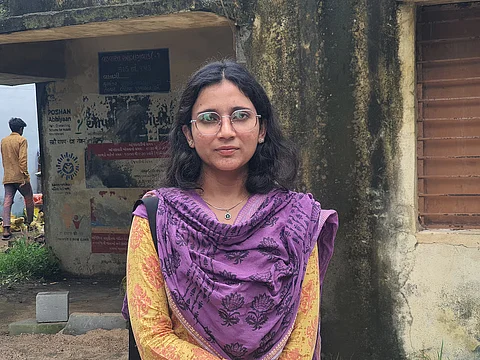

Gujarat held 4,564 Gram Panchayat elections in June 2025; 761 panchayats were elected unopposed (Samras)
25-year-old Satyasha Jagdishchandra Leuva defied social pressure to contest and won by 104 votes
State’s Samras Gram Yojana incentivises consensus panchayats with Rs 3-13 lakh grants
Critics say the scheme undermines the constitutional right to contest elections
Satyasha plans to focus on education, sanitation and youth employment in her village
When 4,564 Gram Panchayat elections were conducted across Gujarat in June 2025, 761 villages avoided the ballot entirely, electing leaders through consensus under the Samras model. These unopposed panchayats are rewarded with cash incentives from the state government, a policy introduced during Narendra Modi’s tenure as Chief Minister and now emulated by other states.
But in Vadvasa, a village in Sabarkantha district, the model met its match.
Satyasha Jagdishchandra Leuva, 25, grew up in Vadvasa and struggled with the village’s poor infrastructure. In her school years, she commuted 7 km daily for classes and tuition, often wading through muddy tracks and returning home after dark, using a mobile phone torch to navigate.
Even today, the village school only runs up to Class 8 and many girls from poorer families drop out early. Dirty water stagnates in the lanes and basic sanitation is lacking.
After completing her law degree in Ahmedabad, Satyasha returned with a clear resolve: to improve the village she grew up in. Inspired by her exposure to student politics in Kerala, she decided to contest the Sarpanch election in 2025.
But village elders had other plans.
Two days before nominations, meetings were held in Vadvasa. Elders and local influencers insisted on following the Samras model, meaning only one candidate would file nomination so the village could secure government grants for being a “harmonious” panchayat.
Satyasha refused to withdraw, seeing this as a violation of her constitutional right to contest. “Even before nominations, influential people call meetings and pressure others to avoid elections,” she told Down To Earth. “This is not democracy.”
Despite pressure from her father and taunts from elders, she filed her nomination. The youth of the village rallied behind her and she won the Sarpanch post by 104 votes.
Though victorious, Satyasha still faces social resistance. Elders continue to remind her that without Samras, the panchayat will not receive extra grants, which can be Rs 3 lakh for panchayats of villages with a population under 5,000.
Her priorities are clear:
Improve education, including setting up a village library
Enhance sanitation and clear stagnant water from lanes
Create youth employment schemes, with support from the administration
Her goal is to bring Vadvasa closer to Kerala’s educational standards, while defending the right to free and fair local elections.
This is Part 4 of our series on Gujarat’s consensus-led panchayats. Read Part 1 on Raningpara, Part 2 on Gathaman and Part 3 on Ukarda.